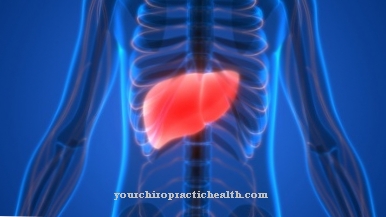The Induced-fit-The theory goes back to Koshland and corresponds to an extension of the key-lock principle, which is based on the accuracy of fit of anatomical structures. Induced-fit refers to enzymes such as kinase that change their conformation to form an enzyme-ligand complex. In the case of enzyme defects, the induced fit principle can be affected by disorders.
What is Induced Fit?

Many processes in the body work on the key-lock or hand-in-glove principle. This applies, for example, to articulated connections. The joint head engages in the joint socket like a key in a lock or a hand in a glove. The door only opens when the key is exactly in the lock. In the same context, certain functions of the body are only opened when structures meet precisely.
Induced-fit is a special form of the key-in-lock principle. This is a theory for the formation of protein-ligand complexes, for example an enzyme-substrate complex in the context of enzyme-catalyzed reactions.
Daniel E. Koshland is considered to be the first to describe the theory and first postulated it in 1958. Unlike the key-lock principle, the induced-fit theory does not assume two static structures. In the case of protein-ligand complexes in particular, a conformational change in the protein involved should enable the complex to be formed. Ligand and protein, or rather enzyme, Koshland viewed as dynamic and spoke of an interaction that moves both partners to a change in conformation for the sake of complex formation.
Function & task
There is binding specificity between enzymes and substrates. This binding specificity implies the key-lock principle. Each enzyme has an active center. For complex formation with a ligand, this center is precisely shaped in such a way that it almost perfectly matches the spatial shape of the intended substrate.
In the case of many enzymes, however, the active center in each case is in a form that is not very precise as long as it is not bound to a substrate. This observation seems to contradict the lock-and-key principle, because enzymes and their ligands initially seem to adapt their shape.
As soon as the enzyme attaches itself to a ligand, intermolecular interactions are created. These interactions at the intermolecular level lead to a change in the conformation of the enzyme. The conformation is understood to mean the various possible arrangements of individual atoms in a molecule that result from a simple rotation around an axis. The change in conformation of enzymes corresponds to a change in the spatial arrangement of their molecules and only enables the formation of an enzyme-substrate complex.
The hexokinase as enzymes catalyze, for example, the first step of glycolysis. As soon as these enzymes come into contact with the substrate glucose, an induced fit in the sense of the formation of an "induced fit" can be observed. The enzyme hexokinase phosphorylates its ligand glucose by consuming ATP to form a glucose-6-phosphate.
The structure of water resembles that within the alcoholic group of the C6 atom, which the enzyme phosphorylates during the reaction. Due to the small size, water molecules could attach themselves to the active center of the enzyme, so that hydrolysis of ATP would be generated. However, the induced-fit allows the hexokinase to catalyze the glucose conversion with high specificity, so that ATP hydrolysis has to take place to a small extent. With the induced-fit mechanism, the substrate specificity increases.
The principle within the human organism can be observed particularly with kinases. The induced adaptation does not apply to every ligand-receptor complex, since the conformational change of both partners is in many cases natural limits.
Illnesses & ailments
The induced-fit principle is disturbed in the case of different enzyme defects. In phenylketonuria, for example, enzymes are restricted in their activity or fail completely. Usually this is due to a genetic defect. In phenylketonuria, the enzyme phenylalanine hydroxylase is defective. Phenylalanine is no longer converted to tyrosine and accumulates accordingly. Neurotoxic substances arise, so that in addition to mental disabilities, the patient has a tendency to cramp. Enzyme defects are usually genetic and are caused by an incorrectly coded amino acid sequence in the DNA.
Metabolic diseases caused by enzyme defects and such a disturbed induced-fit principle are known as enzymopathies. Pyruvate kinase defects are present, for example, in an incorrectly coding PKLR gene. This gene is located on gene locus 1q22 of chromosome 1. Various mutations of the PKLR allele of pyruvate kinase are known, which show up as defects in the R form.
The Hers disease is again referred to as glycogenosis type VI and belongs to the group of glycogen storage diseases. It is an autosomal recessive or X-linked metabolic disorder due to enzyme defects. More precisely, the cause lies in different enzyme defects in the phosphorylase kinase system within the liver and muscles. In this context, for example, the X-linked phosphorylase-b-kinase defect in the liver, the liver phosphorylase defect of the autosomal recessive inheritance and the combined failure of phosphorylase-b-kinase within the liver and muscles are known.
In connection with liver phosphorylase, the causative mutations were localized on the PYGL gene and are therefore on chromosome 14q21 to q22. The combined liver muscle phosphorylase deficiency has been linked to mutations in the PHKB gene at locus 16q12-q13. Causal mutations in the PHKA2 gene on locus Xp22.2-p22.1 were identified for the X-linked defect in liver phosphorylase kinase. Other glycogenoses can also cancel out the induced fit effect of the corresponding kinase or make it more difficult.



























